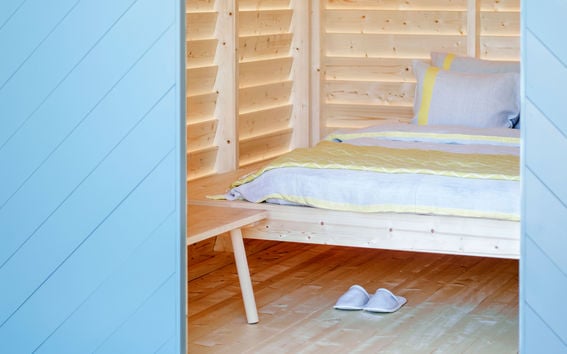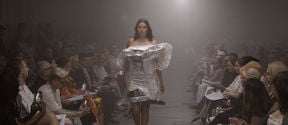
A rustic Finnish cottage, clear and bright. It breathes the tranquillity of a summer night just prior to sunrise. The air is fresh, it is peaceful.
Six cottages will open their doors to bed and breakfast guests in the fast-paced 5th arrondissement of Paris in January. The beds are covered with linen, while bright-light boxes mimic the unique summer light of the far north within the wooden interiors and a breakfast consisting of pure Finnish flavours is set outside on a community table. Visitors go to bed in Paris, but the idea is to experience a summer night in Finland.
This cottage accommodation is available for booking via Airbnb, and up to 12 people can spend a night there from January to May. Beds are in private cottages, while the dining and sanitation facilities are shared with other guests. The village is situated in the exhibition space of the Finnish Institute in France.
Bare essentials only
The minimalist cottages are very reminiscent of Finnish summer cottage living being equipped with only the bare essentials. Everything has been carefully considered. The installation’s tableware was designed by Nathalie Lahdenmäki, while the furniture is the work of designers Laura Mattila and Mikko Merz for Nikari. Overall responsibility rests with lead designer Linda Bergroth.
Bergroth wanted to keep the team relatively small and was responsible for involving Aalto students Salla Luhtasela and Wesley Walters in the KOTI project. Bergroth had seen Piippu, a coffee and tea pot designed by Walters and Luhtasela, and wanted it for the community space.
Luhtasela and Walters also designed a hand mirror and a candle holder for KOTI. The wooden mirror is part of the accommodation space, while the candle holder can be found on the community table alongside their coffee pot.
Dynamic design duo
“We are both very production-oriented designers,” says Wesley Walters.
The California-born design student wound up in Finland via a long and winding road.
“I’ve studied in New York and Japan, where I heard about Finnish design and eventually came here to study.”
By contrast, Salla Luhtasela has always preferred to stay in Finland, apart from an exchange period at London’s Central Saint Martins.
The pair were brought together by a ceramics course. At first, they commented a lot on one another’s work and soon furniture design student Wesley found himself making wooden parts for ceramics student Salla, and vice versa.
Their form language is deliberately sparse and glimpses of both Nordic and Japanese aesthetics can be identified in it. The minimality of the KOTI project is also what they find intriguing.
”It was a good fit for us because we tend to be pretty minimal in our designs,” the duo says.
The furnishings of a typical Finnish summer cottage are fairly bare and clutter-free, and now the task was to design only a very few, hand-picked items for a space that was going to be minimalist by necessity.
“Nature is a central source of inspiration for me,” describes Salla Luhtasela.
Wesley Walters, on the other hand, is fascinated by machinery, structures, metal parts and utilitarian products, things that exist solely for function.
The many meanings of home
The installation and the products will continue their journey from Paris to Finland. The cottages will be on display in Helsinki in the next autumn.
KOTI is a part of the Finnish cultural institutes’ joint Mobile Home 2017 project spanning Paris, the Benelux countries, Berlin and London. Through this project, the institutes are exploring the meaning of homes in major cities. While Paris gets inspired by the Finnish summer cottage tradition, London will examine innovative wood construction. Berlin will study the meaning of home through a spatial installation and the theme in the Benelux countries is homelessness.
Mobile Home 2017 is a part of the Finland 100 Programme.
kotisleepover.com
studiokaksikko.com
Text: Tiiu Pohjolainen. Photo: Kaapo Kamu.
The article was originally published in Aalto University Magazine 18 (issuu.com), December 2016.
- Published:
- Updated:
Read more news

Professor Maarit Salolainen: ‘Multidisciplinary cooperation is the key to solving sustainability issues in the textile field’
Professor of Textile Design Maarit Salolainen wants to see closer cooperation not only between research in different fields but also between the university, the industry and resellers to bring about change.
Reetta Ranta: ‘I try to think about how to make the world a better place’
Alum story: Alum of the School of Arts, Design and Architecture believes that everything we do should involve ethical reflection.
Donor story – Helena Hyvönen: ‘The world is built together, without silos’
Helena Hyvönen has had a long career as Professor of Textile Art, Rector and Dean at the University of Art and Design Helsinki and later Aalto University School of Arts, Design and Architecture. She believes it is important for the field to have a vibrant community of designers. The designers also have a lot to offer to the university.